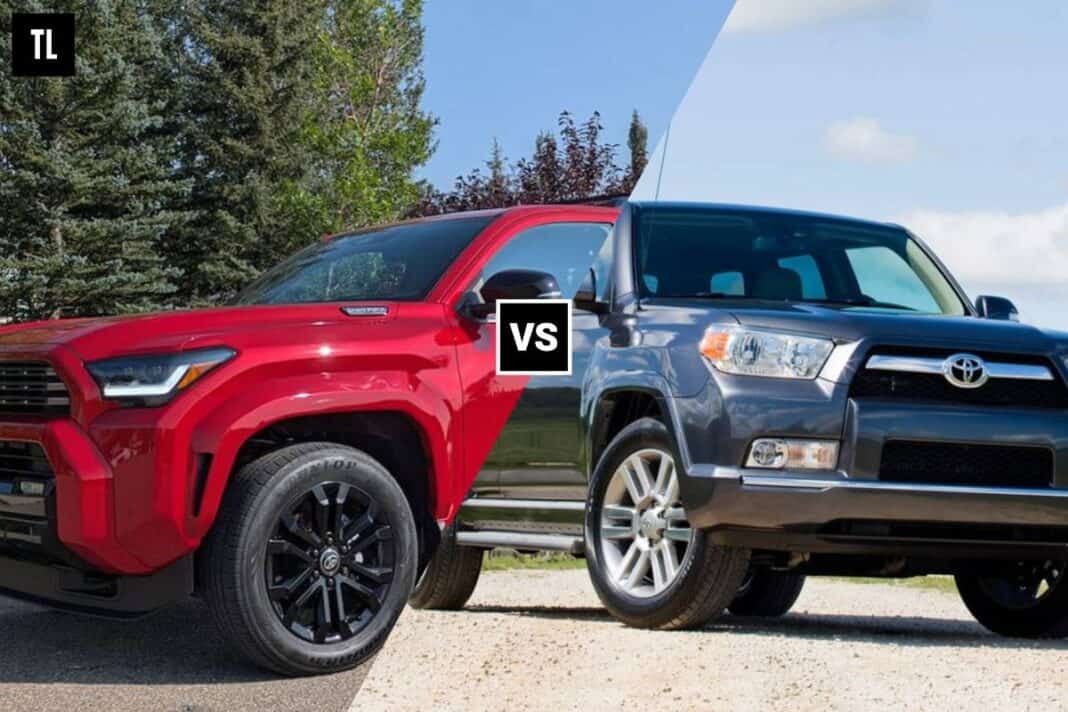Good things come to those who wait. Fans of the Toyota 4Runner – and there are plenty of them – have certainly waited a long time for the sixth-generation model. Expectations are high.
With 15 years of service under its belt, the fifth-generation 4Runner remained popular but was understandably feeling its age, despite regular updates. The new model switches to the same TNGA-F architecture as the Tacoma with which it shares its drivetrains, and incorporates all the technology and amenities you’d expect of a 2025 vehicle.
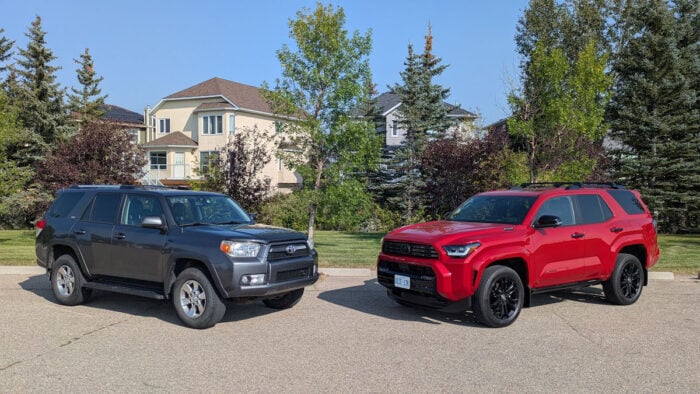
I met up with a 2010 4Runner SR5 owner who bought it new (with over 150,000 miles on it now) to get this thoughts on the new model. First, here are our impressions of the premium 2025 Hybrid Platinum.
Styling and Performance
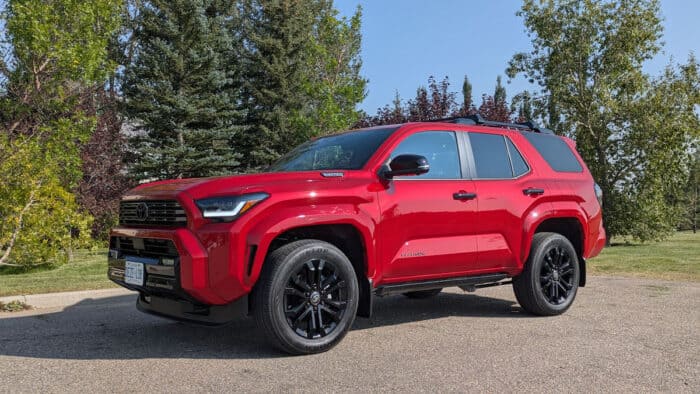
We spent a week with a 4Runner Hybrid Platinum, which has an MSRP of C$73,698 (US$63,360). Only the off-road-focused TRD Pro and overhanding-inspired Trailhunter sit above it in the range, with the Platinum focusing on luxury.
2025 Toyota 4Runner Trims
| Trim | Engine | Power |
|---|---|---|
| SR5 | 2.4L 4-Cylinder Turbo | 278 hp |
| TRD Sport (+ Premium in US) | 2.4L 4-Cylinder Turbo | 278 hp |
| TRD Off Road (US only) and Off Road Premium | 2.4L 4-Cylinder Turbo / Hybrid | 278 hp / 326 hp |
| Limited (no Hybrid in Canada) | 2.4L 4-Cylinder Turbo / Hybrid | 278 hp / 326 hp |
| Platinum | 2.4L 4-Cylinder Turbo Hybrid | 326 hp |
| TRD Pro | 2.4L 4-Cylinder Turbo Hybrid | 326 hp |
| Trailhunter | 2.4L 4-Cylinder Turbo Hybrid | 326 hp |
Related – Every 2025 4Runner Model: Here’s How Toyota Priced Them
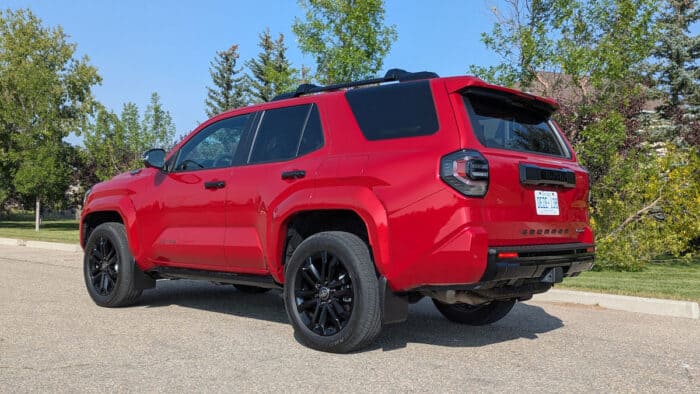
Toyota has retained some styling cues from the outgoing 4Runner, notably the forward-slanting C-pillars. By modern SUV standards, the look is distinctive, while the trapezoidal theme has an appropriately rugged feel. Our test truck was finished in Supersonic Red paint (an extra C$255/US$425) with 20in, black alloy wheels on Dunlop Grandtrek all-seasons.
But remember that this hybrid is there for power, not to save you a fortune on gas.
On-road behaviour is a mixed bag. It steers and brakes well, and has much better pitch control than the old model, so the truck is more settled. But the Platinum model we tried rode very poorly over shorter, sharper bumps in the road, crashing into them and shuddering, instead of swallowing them with any sort of suppleness. Perhaps those massive alloys – the largest available on a 4Runner – are to blame. For a trim level that prioritizes street use (no underbody skid plates here) and is fitted with adaptive variable front suspension (AVS), it’s a concern.
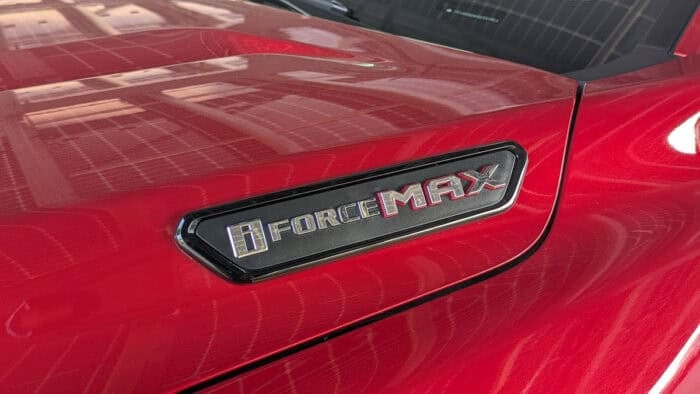
As mentioned, the hybrid powertrain is familiar from the Tacoma, so its torque, refinement and shift-smoothing ability come as no surprise. But remember that this hybrid is there for power, not to save you a fortune on gas. We got 11.4L/100km (21mpg) in mixed driving in summer conditions, about 10% worse than the official combined figure of 10.1L/100km (23mpg). For comparison, the much less-torquey and less-powerful V6 in the 4Runner we tested in 2019 returned 13.3L/100km (18mpg).
Interior Changes
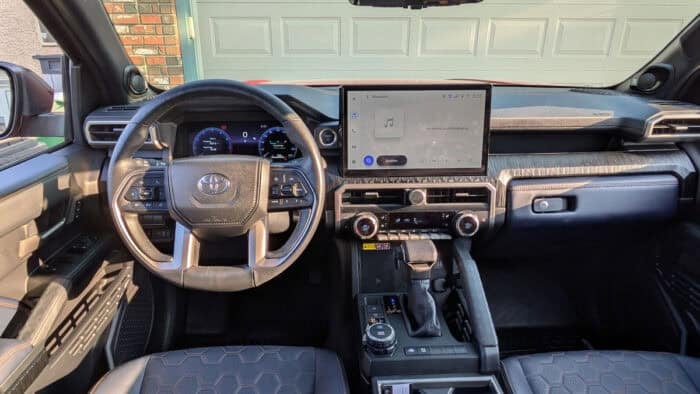
Nowhere is 15 years’ worth of progress more visible than in the new 4Runner’s cabin. It’s nicely styled, with the chamfered edges of the exterior making their way inside, too. Despite the 14.0-inch central screen there are plenty of chunky switches for the main controls. Unfortunately, the switches often feel lightweight and plasticky, as do some other parts of the interior trim.
Ron is 6ft 6in tall and his kids will soon be reaching 6ft. But while the 2025 model is better in this regard, as well as offering good seat adjustment for front-seat passengers, he noted the “tight” rear legroom – even for shorter passengers – as a major drawback.
The screen’s size is great for the panoramic view monitor, but infotainment-wise, there’s not much to fill it unless you pay for Toyota subscription services or – more likely – connect your Android or Apple phone. Frustratingly, the truck repeatedly dropped the wireless Android Auto connection when restarting the engine.
Related – The 2025 Toyota 4Runner Looks Familiar, But There’s a Catch
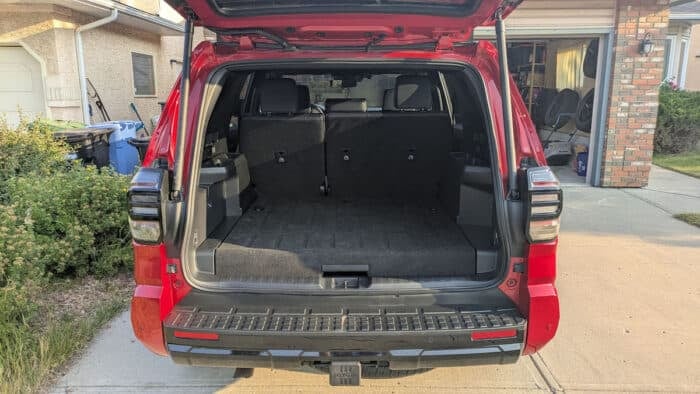
On the plus side, the seats are very supportive, the digital instrument cluster is clear, and the wireless charging pad is helpfully angled to keep the screen visible. Rear legroom is better than in the old 4Runner, but still four inches shy of a Highlander and a couple less than the Bronco. Rear headroom is down slightly, but the truck is easier to get into than before.
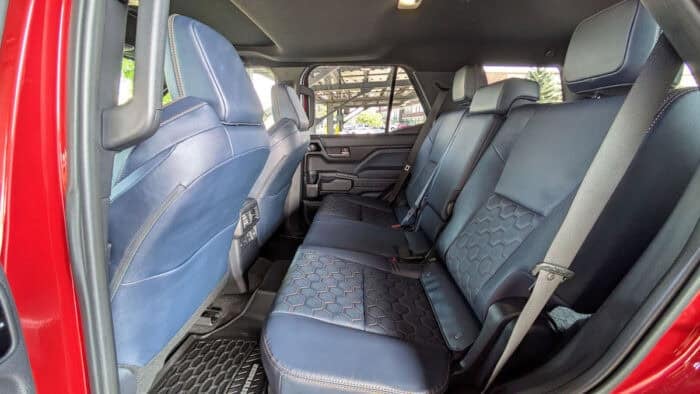
There are only five seats in the Hybrid Platinum because the battery pack sits where the third row otherwise would, under the cargo floor. It also raises that floor, making loading more awkward and diminishing the cargo volume. If you need seven seats then a non-Hybrid SR5 or Limited are your only options. Note that the trunk has a 120V power socket, but the 12V is front-only.
Sixth-Gen Toyota 4Runner Platinum Vs Fifth-Gen SR5: An Owner’s View
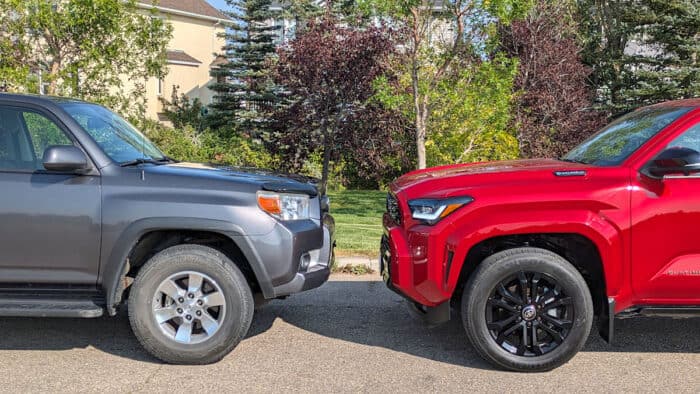
For a different perspective on the 2025 4Runner, I met up with Ron, a Calgarian who bought his now-243,000km SR5 new in 2010 and has recently been researching the new model. He said, “I drive my 4Runner every day, and I love it, but I’ve been looking for something to replace it. It might make sense to buy the same vehicle, but newer. The kids will be driving soon, and we plan to keep the old one for them.”
Part of the attraction for Ron is that his 4Runner has proven to be outstandingly reliable. For example, it has never needed a wheel alignment, despite regular checks.
The skid-plate-less Platinum trim might suit him well, given that the truck would not be used for off-road work beyond unpaved forest tracks and the occasional need to clear ditches or small streams.
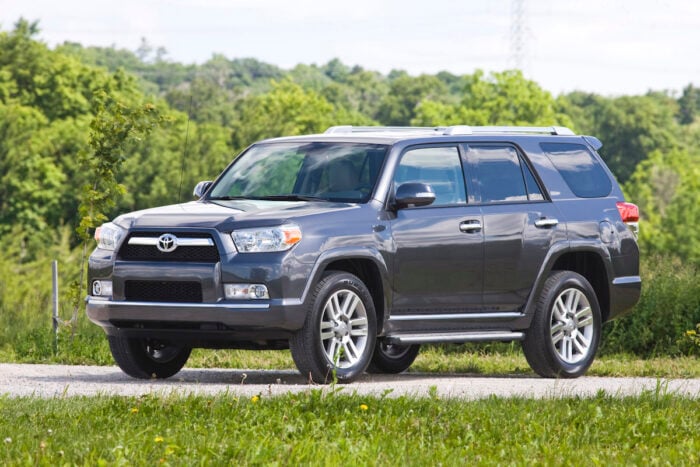
“I use it to tow, but a really busy summer is probably still only eight days of towing,” he continued. “I’ve looked at alternatives. I rented a Ford Bronco but the interior didn’t feel solid. I can’t get a full-size truck in my garage, they’re a hassle to park at the grocery store and they use too much fuel to drive every day.”
Related – 2012 Toyota 4Runner Limited Review: Rugged & Reliable

Part of the attraction for Ron is that his 4Runner has proven to be outstandingly reliable. For example, it has never needed a wheel alignment, despite regular checks. Aside from the usual consumables of tires, brakes and windshields – commonly stone-chipped in Calgary; the SR5 is on its fifth – major repairs in 15 years of ownership have been few. The front sway bar and a corroded rear-window regulator have been replaced. Ron fitted a front-wheel needle bearing himself, with parts from East Coast Gear Supply. He also replaced the headlights with brighter LED units, which, he says, have transformed the visibility on unlit mountain highways.
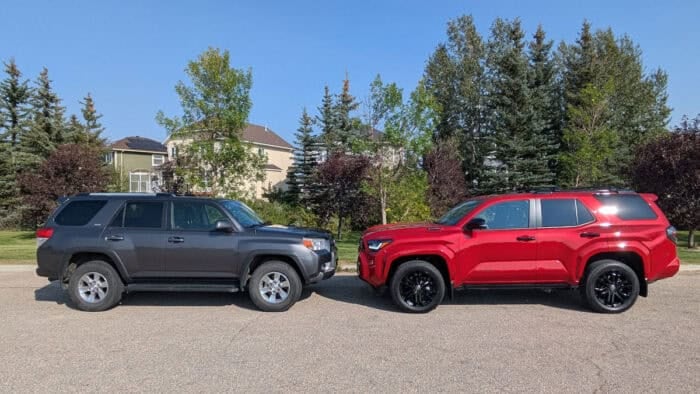
Ron’s 4Runner works hard as family transport during the week – on grocery runs and taking his teenage children to activities – and on long, heavily laden runs to the mountains on weekends. He said that the SR5’s 4-litre V6 can struggle on steep inclines when hauling or towing the family gear. When I took him for a ride in the new 4Runner, he was impressed by the power and the lack of turbo lag.
“With a cold-air intake on it to help with high-load work in the mountains, my V6 makes more noise than power,” he joked. “Even without the trailer, I try to avoid going into top gear at altitude, to keep up momentum. I’ve considered an aftermarket supercharger, but it’s not worth the investment with the truck being so old.
“My trailer is 3,200 lb, gross weight is 4,000,” he added. “My truck is tow-rated for 5,000 lb, but I can’t usually go above 80km/h because of the wind resistance. The new model is rated for 6,000 lb (5,800 for the Hybrid) and the engine performance numbers are dramatically higher, which I think would make a massive difference on the days that I tow a trailer.”

Sitting in the new 4Runner, Ron noted the large, tactile control buttons and dials, and comfortable seats. Occupant space is a drawback in the outgoing model. Ron is 6ft 6in tall and his kids will soon be reaching 6ft. But while the 2025 model is better in this regard, as well as offering good seat adjustment for front-seat passengers, he noted the “tight” rear legroom – even for shorter passengers – as a major drawback.
Another is the aforementioned high trunk floor, especially as he regularly sits on the sheltered tailgate opening to put on ski boots or golf shoes. When we compared the two load spaces, we found that the new one is as deep as in the old model’s, but it was clear that the high floor diminishes the cargo capacity (it’s 1,206 litres vs 1,269 litres) and makes the vehicle harder to load.

More attractive is that Toyota has retained the opening rear window, which he uses all the time. “Especially if I have a paddle board on the roof and bikes on the back, I have trouble opening the tailgate, so it’s a lot easier just to reach in,” he explained, while also admiring the larger storage cubbies in the new 4Runner’s trunk.
He appreciated that the new 4Runner remains a manageable size for city use, easily fitting into an underground parkade, for example. Bronco and Jeep Wrangler aside, the only other body-on-frame SUVs currently on sale are full-size offerings.
Takeaway
Pros:
- Preserves some 4Runner character
- Looks good inside and out
- Few direct rivals
Cons:
- Lack of rear-seat legroom
- Hybrid eats into trunk space
- Disappointing ride comfort
After some time with me in the 2025 4Runner Hybrid, Ron felt that the new model remained the frontrunner to replace his underpowered old SR5. I can see why that would make sense, especially given the paucity of direct competitors.
It’s not a stretch to imagine that many existing 4Runner owners – people for whom the Highlander is too mainstream and the Bronco and Jeep Wrangler a little too extreme – will draw the same conclusion as Ron. For me, the 4Runner Hybrid Platinum makes a solid case for itself, but I can’t escape the thought that the unforgiving ride would make it unpleasant to drive everyday. I’d recommend trying some different wheel, tire and suspension setups before you buy.

